Epson 820P, 600P, 811P User Manual
EPSON® PowerLite® 600p/811p/820p
Multimedia Projector
User’s Guide

Important Safety Information
WARNING: Never look into the projector lens when the lamp is turned on; the bright light can damage your eyes. Never let children look into the lens when it is on. Never open any cover on the projector, except the lamp and filter covers. Dangerous electrical voltages inside the projector can severely injure you. Except as specifically explained in this User’s Guide, do not attempt to service this product yourself. Refer all servicing to qualified service personnel.
WARNING: The projector and its accessories come packaged in plastic bags. Keep plastic bags away from small children to avoid any risk of suffocation.
Caution: When you replace the lamp, never touch the new lamp with your bare hands; the invisible residue left by the oil on your hands may shorten the lamp life. Use a cloth or glove to handle the new lamp.
Copyright Notice
All rights reserved. No part of this publication may be reproduced, stored in a retrieval system, or transmitted in any form or by any means, electronic, mechanical, photocopying, recording, or otherwise, without the prior written permission of SEIKO EPSON CORPORATION. The information contained herein is designed only for use with this EPSON product. EPSON is not responsible for any use of this information as applied to other products.
Neither SEIKO EPSON CORPORATION nor its affiliates shall be liable to the purchaser of this product or third parties for damages, losses, costs, or expenses incurred by purchaser or third parties as a result of: accident, misuse, or abuse of this product or unauthorized modifications, repairs, or alterations to this product, or (excluding the U.S.) failure to strictly comply with SEIKO EPSON CORPORATION’s operating and maintenance instructions.
SEIKO EPSON CORPORATION shall not be liable for any damages or problems arising from the use of any options or any consumable products other than those designated as Original EPSON Products or EPSON Approved Products by SEIKO EPSON CORPORATION.
EPSON is a registered trademark of SEIKO EPSON CORPORATION.
EPSON Connection, EPSON Store, and Extra Care, are service marks; SizeWise is a trademark; and PrivateLine, Presenters Club, and PowerLite are registered trademarks of Epson America, Inc.
General Notice: Other product names used herein are for identification purposes only and may be trademarks of their respective owners. EPSON disclaims any and all rights in those marks.
Copyright © 2002 by Epson America, Inc. |
4/02 |
Printed on recycled paper. |
CPD-13953 |
ii

CContents
Welcome . . . . . . . . . . . . . . . . . . . . . . . . . . . . . . . . . . . . . . 1 Getting the Most from Your Projector . . . . . . . . . . . . . . . . . . 2 Using Your Documentation . . . . . . . . . . . . . . . . . . . . . . . . . . 3 Getting More Information . . . . . . . . . . . . . . . . . . . . . . . . 3 Registration and Warranty . . . . . . . . . . . . . . . . . . . . . . . . . . . 4 Unpacking the Projector. . . . . . . . . . . . . . . . . . . . . . . . . . . . . 5 Additional Components. . . . . . . . . . . . . . . . . . . . . . . . . . 6 Optional Accessories . . . . . . . . . . . . . . . . . . . . . . . . . . . . 7
|
Setting Up the Projector . . . . . . . . . . . . . . . . . . . . . |
. 9 |
1 |
Positioning the Projector . . . . . . . . . . . . . . . . . . . . . . . . . . . |
10 |
|
Connecting to a Laptop Computer. . . . . . . . . . . . . . . . . . . . |
12 |
|
Connecting the Computer Cable . . . . . . . . . . . . . . . . . . |
12 |
|
Connecting the Cable for Remote Mouse Control . . . . . |
13 |
|
Amplifying Computer Audio . . . . . . . . . . . . . . . . . . . . . |
14 |
|
Connecting to Video Sources . . . . . . . . . . . . . . . . . . . . . . . . |
15 |
|
Connecting the RCA A/V Cable . . . . . . . . . . . . . . . . . . |
16 |
|
Connecting an S-Video Cable . . . . . . . . . . . . . . . . . . . . |
17 |
|
Connecting a Component Video Cable . . . . . . . . . . . . . |
18 |
|
Using the Projector . . . . . . . . . . . . . . . . . . . . . . . . . . |
19 |
2 |
Turning On Your Equipment. . . . . . . . . . . . . . . . . . . . . . . . |
20 |
|
Turning On the Projector . . . . . . . . . . . . . . . . . . . . . . . |
20 |
|
What To Do If You See a Blank Screen . . . . . . . . . . . . . |
22 |
|
Adjusting the Image . . . . . . . . . . . . . . . . . . . . . . . . . . . . . . . |
24 |
|
Focusing and Zooming Your Image . . . . . . . . . . . . . . . . |
25 |
|
Adjusting the Height of Your Image . . . . . . . . . . . . . . . |
26 |
|
Adjusting the Image Shape. . . . . . . . . . . . . . . . . . . . . . . |
27 |
|
Resizing the Image . . . . . . . . . . . . . . . . . . . . . . . . . . . . . |
28 |
|
Adjusting the Tracking and Synchronization . . . . . . . . . |
28 |
iii

|
Controlling the Projector . . . . . . . . . . . . . . . . . . . . . . . . . . . |
29 |
|
Switching Between Picture Sources . . . . . . . . . . . . . . . . |
29 |
|
Adjusting the Volume . . . . . . . . . . . . . . . . . . . . . . . . . . |
29 |
|
Turning Off the Picture and Sound . . . . . . . . . . . . . . . |
30 |
|
Shutting Down the Projector . . . . . . . . . . . . . . . . . . . . . . . . |
30 |
|
Using the Remote Control . . . . . . . . . . . . . . . . . . . |
33 |
3 |
Turning On and Using the Remote Control . . . . . . . . . . . . |
34 |
|
Installing Batteries . . . . . . . . . . . . . . . . . . . . . . . . . . . . |
34 |
|
Turning On the Remote Control. . . . . . . . . . . . . . . . . . |
34 |
|
Using the Remote Control. . . . . . . . . . . . . . . . . . . . . . . |
35 |
|
Controlling the Picture and Sound. . . . . . . . . . . . . . . . . . . . |
35 |
|
Switching Between Picture Sources . . . . . . . . . . . . . . . . |
35 |
|
Adjusting the Volume . . . . . . . . . . . . . . . . . . . . . . . . . . |
36 |
|
Turning Off the Picture and Sound . . . . . . . . . . . . . . . |
36 |
|
Stopping Action. . . . . . . . . . . . . . . . . . . . . . . . . . . . . . . |
36 |
|
Zooming Your Image. . . . . . . . . . . . . . . . . . . . . . . . . . . |
37 |
|
Resizing the Image . . . . . . . . . . . . . . . . . . . . . . . . . . . . . |
37 |
|
Displaying Picture-in-Picture Video . . . . . . . . . . . . . . . |
38 |
|
Highlighting Your Presentation . . . . . . . . . . . . . . . . . . . . . . |
39 |
|
Using the Pointer. . . . . . . . . . . . . . . . . . . . . . . . . . . . . . |
39 |
|
Spotlighting Your Image . . . . . . . . . . . . . . . . . . . . . . . . |
40 |
|
Using Horizontal and Vertical Highlights . . . . . . . . . . . |
40 |
|
Using the Remote Control as a Wireless Mouse . . . . . . . . . . |
41 |
|
Fine-tuning the Projector. . . . . . . . . . . . . . . . . . . . |
43 |
4 |
Using the Projector’s Menu System . . . . . . . . . . . . . . . . . . . |
44 |
|
Changing Menu Settings . . . . . . . . . . . . . . . . . . . . . . . . |
45 |
|
Adjusting the Image . . . . . . . . . . . . . . . . . . . . . . . . . . . . . . . |
47 |
|
Repositioning the Image . . . . . . . . . . . . . . . . . . . . . . . . |
48 |
|
Adjusting Image Appearance . . . . . . . . . . . . . . . . . . . . . |
48 |
|
Saving and Recalling Computer Settings . . . . . . . . . . . . |
50 |
|
Adjusting the Sound. . . . . . . . . . . . . . . . . . . . . . . . . . . . . . . |
51 |
|
Customizing the Highlighting Tools . . . . . . . . . . . . . . . . . . |
52 |
|
Creating Your Own Startup Screen . . . . . . . . . . . . . . . . . . . |
53 |
|
Capturing the Image . . . . . . . . . . . . . . . . . . . . . . . . . . . |
53 |
|
Choosing When to Display the Image . . . . . . . . . . . . . |
54 |
iv

|
Customizing Projector Features . . . . . . . . . . . . . . . . . . . . . . |
55 |
|
Setting Advanced Features . . . . . . . . . . . . . . . . . . . . . . . |
57 |
|
Viewing Lamp Usage and Other Information. . . . . . . . . . . . |
58 |
|
Restoring the Default Settings . . . . . . . . . . . . . . . . . . . . . . . |
59 |
5 theMaintainingProjector .and. . . . .Transporting. . . . . . . . . . . . . . . . . . . . . . . . . . . |
61 |
|
|
Cleaning the Lens . . . . . . . . . . . . . . . . . . . . . . . . . . . . . . . . . |
62 |
|
Cleaning the Projector Case . . . . . . . . . . . . . . . . . . . . . . . . . |
62 |
|
Cleaning and Replacing the Air Filter . . . . . . . . . . . . . . . . . . |
63 |
|
Replacing the Lamp . . . . . . . . . . . . . . . . . . . . . . . . . . . . . . . |
64 |
|
Resetting the Lamp Timer . . . . . . . . . . . . . . . . . . . . . . . |
67 |
|
Transporting the Projector . . . . . . . . . . . . . . . . . . . . . . . . . . |
68 |
|
Solving Problems . . . . . . . . . . . . . . . . . . . . . . . . . . . . |
69 |
6 |
Using On-Screen Help . . . . . . . . . . . . . . . . . . . . . . . . . . . . . |
70 |
|
What To Do When the Lights Flash. . . . . . . . . . . . . . . . . . . |
71 |
|
Solving Problems with the Image or Sound . . . . . . . . . . . . . |
73 |
|
Solving Problems with the Remote Control . . . . . . . . . . . . . |
79 |
|
Where To Get Help . . . . . . . . . . . . . . . . . . . . . . . . . . . . . . . |
80 |
|
Telephone Support Services . . . . . . . . . . . . . . . . . . . . . . |
80 |
|
Appendix A: Connecting to |
|
A |
Additional Equipment . . . . . . . . . . . . . . . . . . . . . . |
81 |
|
Installing the Projector . . . . . . . . . . . . . . . . . . . . . . . . . . . . . |
82 |
|
Controlling the Projector from a Computer . . . . . . . . . . |
83 |
|
Connecting to an External Audio System . . . . . . . . . . . . |
83 |
|
Connecting to a PC Desktop Computer. . . . . . . . . . . . . . . . |
84 |
|
Connecting the Computer Cable . . . . . . . . . . . . . . . . . . |
84 |
|
Connecting the Mouse Cable. . . . . . . . . . . . . . . . . . . . . |
86 |
|
Connecting the Audio Cable . . . . . . . . . . . . . . . . . . . . . |
87 |
|
Connecting to a Desktop Macintosh . . . . . . . . . . . . . . . . . . |
88 |
|
Connecting the Computer Cable . . . . . . . . . . . . . . . . . . |
88 |
|
Connecting the Mouse Cable. . . . . . . . . . . . . . . . . . . . . |
90 |
|
Connecting the Audio Cable . . . . . . . . . . . . . . . . . . . . . |
91 |
|
Connecting to a Second Computer. . . . . . . . . . . . . . . . . . . . |
92 |
v

|
Connecting to a High-End Workstation . . . . . . . . . . . . . . |
. 93 |
|
Connecting to a DVI Video Source . . . . . . . . . . . . . . . . . . |
. 93 |
|
Appendix B: Notices . . . . . . . . . . . . . . . . . . . . . . . . |
. 95 |
B |
Important Safety Instructions . . . . . . . . . . . . . . . . . . . . . . . |
. 95 |
|
Remote Control Information . . . . . . . . . . . . . . . . . . . . . . . |
. 97 |
|
Declaration of Conformity . . . . . . . . . . . . . . . . . . . . . . . . . . |
98 |
|
FCC Compliance Statement. . . . . . . . . . . . . . . . . . . . . . . . . |
99 |
|
Warranty . . . . . . . . . . . . . . . . . . . . . . . . . . . . . . . . . . . . . . |
100 |
|
Appendix C: Technical Specifications. . . . . . |
103 |
C |
General. . . . . . . . . . . . . . . . . . . . . . . . . . . . . . . . . . . . . . . . |
103 |
|
Projection Lamp. . . . . . . . . . . . . . . . . . . . . . . . . . . . . . . . . |
104 |
|
Remote Control . . . . . . . . . . . . . . . . . . . . . . . . . . . . . . . . . |
104 |
|
Mouse Compatibility . . . . . . . . . . . . . . . . . . . . . . . . . . . . . |
104 |
|
Dimensions . . . . . . . . . . . . . . . . . . . . . . . . . . . . . . . . . . . . |
104 |
|
Electrical . . . . . . . . . . . . . . . . . . . . . . . . . . . . . . . . . . . . . . |
104 |
|
Environmental . . . . . . . . . . . . . . . . . . . . . . . . . . . . . . . . . . |
105 |
|
Safety . . . . . . . . . . . . . . . . . . . . . . . . . . . . . . . . . . . . . . . . . |
105 |
|
Computer Video Port Pin Assignments . . . . . . . . . . . . . . . |
105 |
|
Compatible Video Formats . . . . . . . . . . . . . . . . . . . . . . . . |
106 |
|
ESC/VP21 Commands . . . . . . . . . . . . . . . . . . . . . . . . . . . |
108 |
|
Index. . . . . . . . . . . . . . . . . . . . . . . . . . . . . . . . . . . . . . . . |
109 |
vi

W-Welcome
The EPSON® PowerLite® 600p, 811p, and 820p are portable projectors that weigh less than 10 pounds and offer up to 2500 ANSI lumens of brightness. From classrooms to auditoriums, your full-color presentations and videos will be bright and visible even in ordinary room lighting.
Images are displayed at a resolution of 1024 × 768 pixels (PowerLite 811p and 820p) or 800 × 600 pixels (PowerLite 600p). The 0.9-inch LCD provides a high contrast ratio for incredibly vivid images and clear text. Improved color processing technology reduces “video noise” for rich, saturated images, while 5-watt amplified sound and whisper-quiet operation contribute to theater-quality video.
With EPSON’s patented SizeWise™ chip, the projector supports computer displays ranging from VGA through UXGA (or SXGA on the PowerLite 600p). The projector also supports the Digital Visual Interface (DVI) format.
You can connect the projector to a wide range of computers, including PCs and laptops, Apple® Macintosh,® Power Macintosh® series (including G3 and G4 systems), PowerBook® computers, many iMac® and iBook® series systems, and high-end workstations such as the Sun® SPARCstation™.
You can use any of the following video sources: VCR, DVD player, camcorder, digital camera, or laser disc player. The projector supports composite video, S-Video, and component video, and it automatically senses the video format (HDTV, NTSC, PAL, or SECAM).
Support for USB audio and horizontal keystone control contribute to ease of setup in a wide variety of environments.
Welcome 1

note
You can connect a maximum of four sources at the same time.
Getting the Most from Your Projector
Your EPSON PowerLite projector is a highly versatile presentation tool. You can connect it to one or two computer sources and up to three video sources and easily switch between them. You can also include sound for up to three of the sources.
Depending on your presentation, you can take advantage of any or all of these options:
■Connecting to a laptop or other computer
If you want to connect to a PC laptop or Macintosh PowerBook or iBook, see page 12. To connect to a desktop computer, a workstation, a computer that outputs video in Digital Visual Interface (DVI) format, or more than one computer, see Appendix A.
■Connecting to video sources
You can connect a DVD player, VCR, camcorder, laser disc player, digital camera, or any other video source to your projector. You can connect up to three video sources at the same time (with or without a computer) and easily switch between them.
See page 15 for instructions.
■Using the remote control
The remote control lets you switch from one computer or video source to another, with access to picture-in-picture, pointer, zoom, and many other projector features. For details, see Chapter 3.
By connecting an additional cable, you can also use the remote control as a wireless mouse. This lets you click through slideshow-style presentations (such as PowerPoint®) from up to 30 feet away. For more information, see page 41.
■Including sound in your presentation
If your presentation includes sound, you can connect the USB cable or an optional audio cable to use the projector’s built-in speakers. For details, see page 14 (for laptops) or Appendix A (for other systems).
2 Welcome

If you’re permanently installing the projector, you may wish to connect external speakers or a public address system to the projector’s Audio Out port; see page 83.
■Controlling the Projector from a Computer
If you want to be able to control the projector’s settings from a computer (for example, if the projector is ceiling-mounted), you can install the EMP Link program. You can download this program, plus its User’s Guide, from EPSON’s web site at support.epson.com. You’ll also need a serial or USB cable to connect the projector to the computer.
Using Your Documentation
To connect the projector to your laptop and get your presentation up and running fast, see the Quick Setup sheet in your owner’s kit.
This book contains all the information you need to set up and use your projector. Please follow these guidelines as you read through it:
■Warnings must be followed carefully to avoid bodily injury.
■Cautions must be observed to avoid damage to your equipment.
■Notes contain important information about your projector.
Getting More Information
Need tips on giving presentations? Quick steps for setting up your projector? Here’s where you can look for help:
■presentersonline.com
Includes a library of articles covering presentation tips, tricks, and technology. The site provides templates, clip art and sound clips, as well as Presenters Services to use on the road. Even more resources and services are available if you register to join the Presenters Club®—and it’s free.
■Quick Setup sheet
Gives you all the instructions you need to get your projector set up and connected to a laptop or PowerBook computer.
Welcome 3

■Owner’s Kit
Includes your Quick Setup sheet, warranty brochures, and EPSON PrivateLine® Support card. Store this User’s Guide in the folder and keep the folder with your projector at all times.
■Built-in help system
Provides assistance for common problems. Available from the Help button on the projector or the remote control. See page 70 for details.
■support.epson.com
Download FAQs and e-mail your questions to EPSON support.
If you still need help after checking this User’s Guide and the sources listed above, you can use the EPSON PrivateLine Support service to get help fast. Call (800) 637-7661 and enter the PIN on the card in your owner’s kit. Or take advantage of EPSON’s automated support services 24 hours a day. See page 80 for more information.
Registration and Warranty
Your projector comes with a basic carry-in warranty (on page 100) as well as an international warranty that let you project with confidence anywhere in the world. For details, see the warranty brochure included in your owner’s kit.
In addition, for customers who register their projector, EPSON offers free Extra CareSM Road Service. In the unlikely event of an equipment failure, you won’t have to wait for your unit to be repaired. Instead, EPSON will ship you a replacement unit anywhere in the United States or Canada, usually via overnight delivery. See the brochure in your owner’s kit for details.
To register, simply fill out the registration card included in your owner’s kit and mail it to EPSON. Or you can register online at http://epsonwebreg.info2.net/. Registering also lets you receive special updates on new accessories, products, and service.
4 Welcome
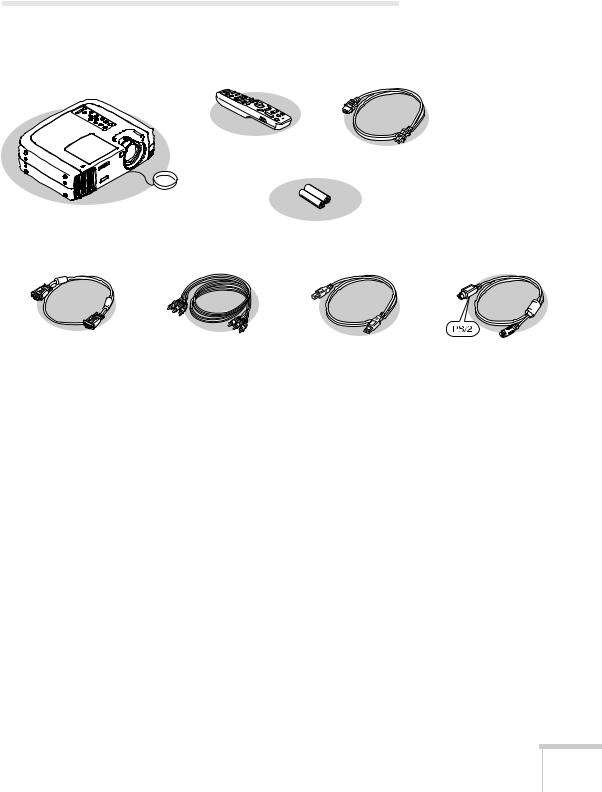
Unpacking the Projector
After unpacking the projector, make sure you have all the parts shown below:
remote control |
power cord |
|
projector
batteries
computer cable |
A/V cable |
USB cable |
PS/2 mouse cable |
Save all packaging in case you need to ship the projector. Always use the original packaging (or the equivalent) when you need to send the projector to another location.
If you are moving the projector by hand, use a carrying case (such as the optional cases available from EPSON). See page 7 for more information about cases.
Welcome 5

Additional Components
Depending on how you plan to use the projector, you may need additional components:
■
■
To receive an S-Video signal, you need an S-Video cable. (One is usually provided with your video device.)
To receive a component video signal from a VCR or other video device, you need a VGA-to-component video cable. You can purchase this from EPSON; see page 7.
■To connect two computers to the projector at the same time, you need a DVI/analog interface cable. You can purchase this from EPSON; see page 7.
■Some older PowerBooks and Macintosh desktop models may need the Macintosh adapter set shown on page 89 (available from EPSON; see page 7). Older iMac systems may need a special adapter to provide a VGA output port; see your computer dealer.
■Some systems may need an additional cable to use the remote control as a wireless mouse. If your Macintosh doesn’t have a USB port, you’ll need a Macintosh mouse cable. If your PC doesn’t have a USB or PS/2 port, you’ll need a PC serial mouse cable. See your projector dealer to obtain the correct cable.
■To take advantage of the projector’s Digital Visual Interface, you need a DVI cable, and your computer must be capable of producing video signals in DVI format (for details, see page 93). You can purchase this cable from EPSON; see page 7.
■To receive an audio signal, you may need a stereo mini-jack cable, available from most electronics dealers.
6 Welcome

Optional Accessories
To enhance your use of the projector, EPSON provides the following optional accessories. You can purchase these accessories from your dealer, by calling EPSON at (800) 873-7766, or by visiting the EPSON StoreSM at www.epsonstore.com (U.S. sales only). In Canada, please call (800) 463-7766 for dealer referral.
Product |
Product number |
|
|
Replacement lamp and air filter |
V13H010L15 |
|
|
Customized carrying cases: |
|
Samsonite® wheeled soft case |
ELPKS35 |
ATA molded hard shell case |
ELPKS40 |
ATA shipping case |
ELPKS41 |
Soft shoulder bag |
ELPKS13 |
|
|
Ceiling mount |
ELPMB36 |
Suspension adapter |
ELPMBAPL |
False ceiling plate |
ELPMBFCP |
|
|
Kensington® security lock |
ELPSL01 |
Projection screens: |
|
50-inch portable screen |
ELPSC06 |
60-inch Insta Theatre screen |
ELPSC07 |
80-inch Insta Theatre screen |
ELPSC08 |
|
|
Wireless microphone and two satellite speakers |
ELPCVSII |
|
|
Auxiliary audio system |
ELPPAS1 |
|
|
Remote control receiver (plugs into projector to |
ELPST02 |
extend range of remote control) |
|
|
|
Remote control receiver kit (includes standard |
ELPST04 |
receiver and clip-on receiver for attachment directly |
|
to remote control) |
|
|
|
Macintosh adapter set (includes monitor adapter |
ELPAP01 |
and desktop adapter) |
|
|
|
Component video cable (VGA to component video) |
ELPKC19 |
|
|
Digital video cables: |
|
DVI to DVI, 10 feet (3 meters) |
ELPKC20 |
DVI to DFP, 10 feet (3 meters) |
ELPKC21 |
DVI to analog video, 10 feet (3 meters) |
V12H005C25 |
|
|
High resolution document imager |
ELPDC02 |
Motion presentation camera |
ELPDC03 |
High resolution document camera |
V12H064020 |
|
|
Welcome 7

8 Welcome

1Setting Up the Projector
This chapter tells you how to set up the projector for a laptop computer or video presentation. If you need to set up the projector for a permanent installation or connect it to a desktop or workstation computer, see Appendix A.
You’ll find instructions for the following in this chapter:
■Positioning the projector
■Connecting to a laptop computer
■Connecting to video sources
Setting Up the Projector 9
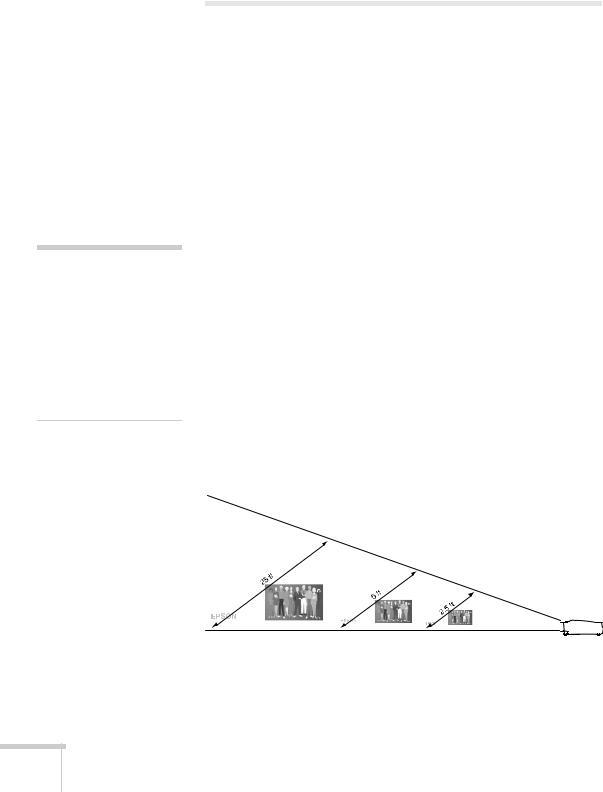
note
It’s easier to position the projector when the screen is directly in front of the room. However, if you need to place it off-center, you can use the keystone correction feature to maintain a square image. See page 27 for more information.
Positioning the Projector
Before connecting the projector, you need to decide where to place it. The location you choose depends on the size of the room and what you are projecting.
■Place the projector on a sturdy, level surface, approximately 2.85 to 41 feet from the screen.
■Make sure there is plenty of space for ventilation around and under the projector.
■Make sure the projector is within 10 feet of a grounded electrical outlet or extension cord, and within 5 feet of your computer and/or video source.
■Place the projector directly in front of the center of the screen, facing it toward the screen squarely.
Most presenters find it convenient to place the projector in front of the audience, leaving as much space as possible between the projector and the screen to get a good-sized image. This lets the presenter stand in the front of the room, face the audience, and remain close enough to the equipment to be able to control it.
Use the figure below as a guideline to help you determine how far from the screen to place the projector. Image size generally increases with distance, but may vary depending on how you position the zoom ring and whether you have adjusted the image size with other settings.
|
|
|
|
|
|
|
|
|
|
|
|
|
|
|
|
|
|
|
|
|
|
|
|
|
|
|
|
|
|
|
|
|
|
|
|
|
|
|
|
|
|
|
30 to 41 ft |
6 to 8 ft |
|
3 to 4 ft |
distance from screen |
||||||||
10 Setting Up the Projector
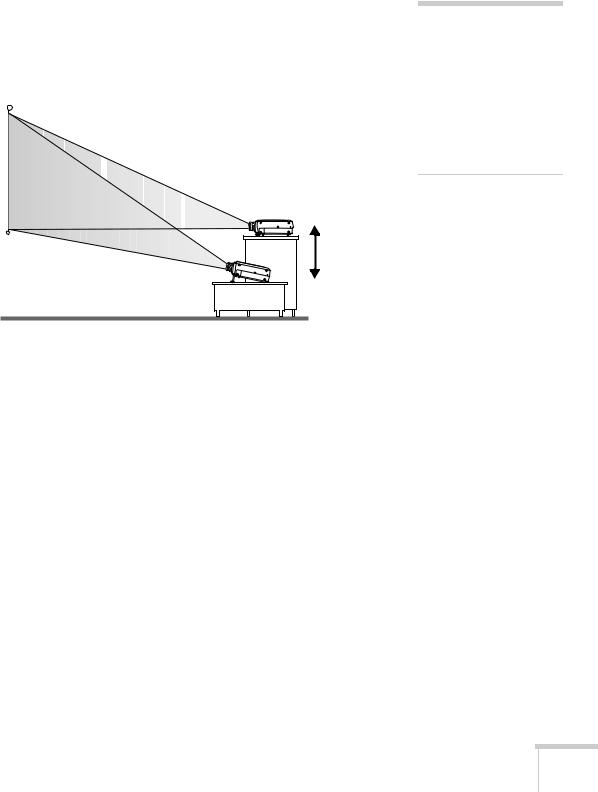
If you place the projector below the level of the screen, you’ll have to tilt it up by extending the feet as shown. Tilting the projector upward causes the image to lose its square shape, but you can correct the distortion by pressing the Keystone button as described in the next chapter.
ideal height
note
After positioning the projector, you may want to connect a Kensington MicroSaver® anti-theft device to the lock port on the projector’s left side. You can purchase this from EPSON; see “Optional Accessories” on page 7.
If you place the projector level with the bottom of the screen, the image will be square and you won’t have to adjust it. If you place the projector higher than the bottom of the screen, the image will still be square, but you won’t be able to fill the whole screen with the image.
Setting Up the Projector 11
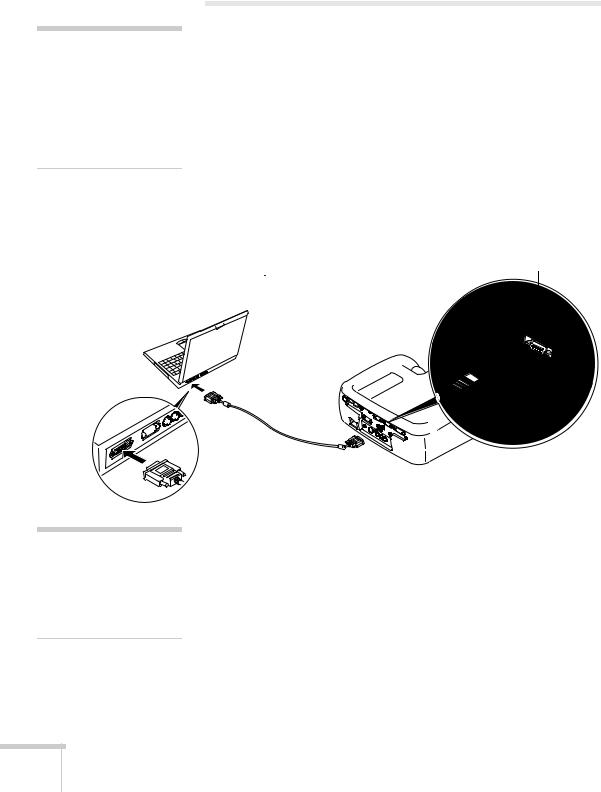
note
To connect to desktops and other computer systems, see Appendix A. If you have an iBook with an RCA video-out port, follow the
instructions for connecting to a video device on page 16.
note
Laptop configurations vary. See your computer manual for the location of the ports needed to connect your projector.
Connecting to a Laptop Computer
You can connect the PowerLite projector to any computer that has a standard video output (monitor) port, including PC notebook and laptop computers, Macintosh PowerBooks and iBooks, and hand-held devices.
Connecting the Computer Cable
Before you start, make sure your computer and the projector are turned off.
1.Connect one end of the computer cable to the projector’s
Computer2/Component Video port.
Computer2/Component Video port
2.Connect the other end of the computer cable to your laptop’s video-out or monitor port.
If you’re using a PowerBook and you can’t connect the cable, you may need to use the Macintosh desktop adapter as shown on page 89 (available from EPSON; see page 7).
3.Tighten the screws on the connectors.
If you don’t need to make any other connections, you can plug in your projector and turn it on. See page 20 for instructions.
12 Setting Up the Projector
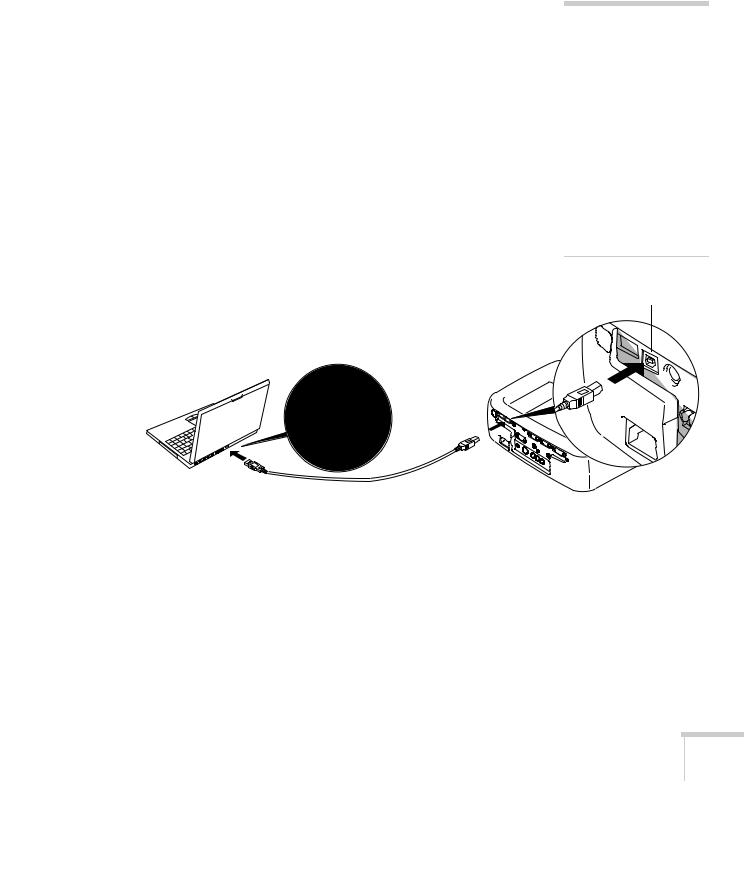
Connecting the Cable for Remote Mouse Control
Using the remote control as a wireless mouse lets you control your computer and click through slideshow-style presentations, such as PowerPoint, from up to 30 feet away (for details, see page 41). This gives you more flexibility in delivering your presentation, since you won’t need to stand near your computer.
The USB cable also provides audio support. If your presentation includes sound, you can play it through the projector’s speakers by connecting the USB cable.
1.Locate the cable you need, depending on whether your laptop has a round PS/2 mouse port or a flat USB mouse port.
2.Connect one end of the cable to the projector’s 
 USB or
USB or
Mouse port.
USB cable
3.Connect the other end of the cable to the external mouse port or USB port on your laptop.
4.If necessary, configure your laptop to work with an external mouse.
If you don’t need to make any other connections, you can plug in your projector and turn it on. See page 20 for instructions.
note
If you’re using a PowerBook that has a round mouse port, you’ll need a Macintosh mouse cable. If you have a PC laptop with a serial mouse port, you’ll need a serial mouse cable. See your projector dealer to obtain the correct cable.
On a PowerBook or iBook, USB audio support is available for Mac OS 9.0 and 9.1 only.
USB port
Setting Up the Projector 13
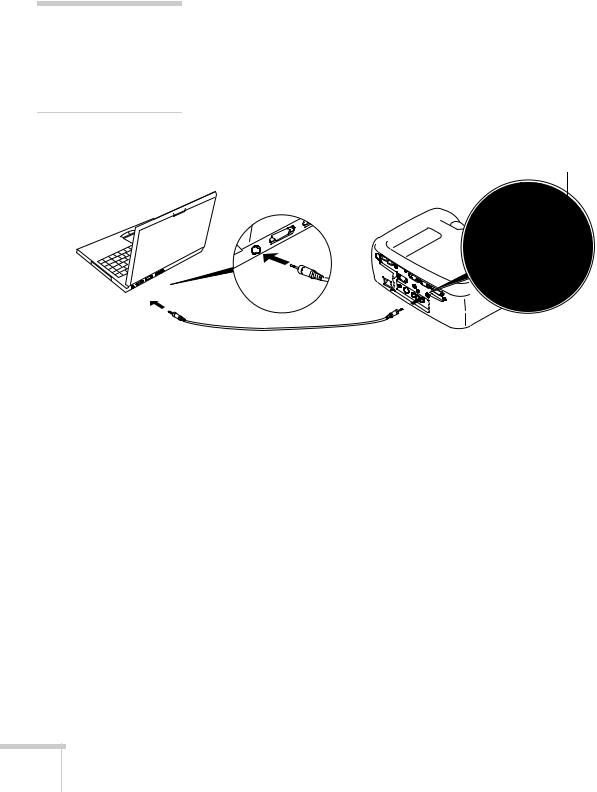
note
If you connected the USB cable, you may not need a separate audio cable to amplify audio from your computer.
Amplifying Computer Audio
Your laptop probably has its own sound system; however, it may not be adequate for your presentation. If you need more volume or better sound quality, you can connect a stereo, mini-jack audio cable (not included).
1.Connect one end of the audio cable to the Audio1 jack on the projector.
Audio1 jack
audio cable
2. Connect the other end of the audio cable to your laptop’s
 headphone jack or
headphone jack or 
 audio-out jack. (Jack locations vary; see your computer manual if you’re not sure which jack to use.)
audio-out jack. (Jack locations vary; see your computer manual if you’re not sure which jack to use.)
If you don’t need to make any other connections, you can plug in your projector and turn it on. See page 20 for instructions.
14 Setting Up the Projector
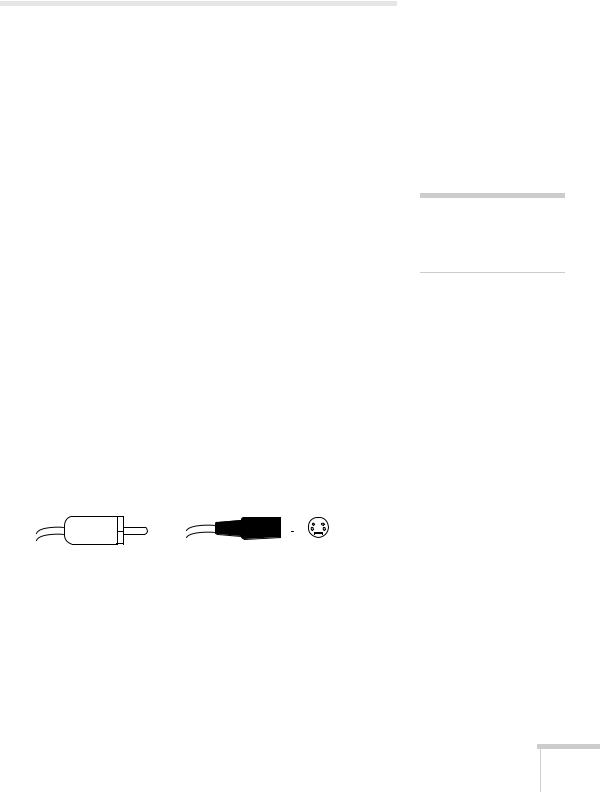
Connecting to Video Sources
You can connect a DVD player, VCR, camcorder, laser disc player, digital camera, or any other compatible video source to your projector.
The projector supports HDTV, NTSC, PAL, and SECAM, and automatically detects the video format.
The projector can receive composite video, S-Video, and component video. You can connect one or more of these video sources at the same time.
The type of cable you use depends on whether you have composite video, S-Video, or component video.
■For composite video, use the RCA A/V cable included with the projector.
■For S-Video, use the S-Video cable supplied with your video device or obtain one from your electronics dealer.
■For component video, you’ll need a VGA-to-component video cable. You can purchase this from EPSON; see page 7. Component video connectors are usually colored green, blue, and red.
See the following illustration if you’re not sure which type of connectors you have.
composite video |
|
|
|
|
|
|
|
|
S-Video |
|
||||
RCA connector |
|
4-pin, mini-DIN |
|
|||||||||||
|
|
|
|
|
|
|
|
|
|
|
|
|
|
|
|
|
|
|
|
|
|
|
|
|
|
|
|
|
|
|
|
|
|
|
|
|
|
|
|
|
|
|
|
|
|
|
|
|
|
|
|
|
|
|
|
|
|
|
|
|
|
|
|
|
|
|
|
|
|
|
|
|
|
|
|
|
|
|
|
|
|
|
|
|
|
|
|
|
|
|
|
|
|
|
|
|
|
|
|
|
|
|
|
|
Follow the instructions below for your type of connection.
note
The projector does not support TV antenna cable F-connectors.
Setting Up the Projector 15
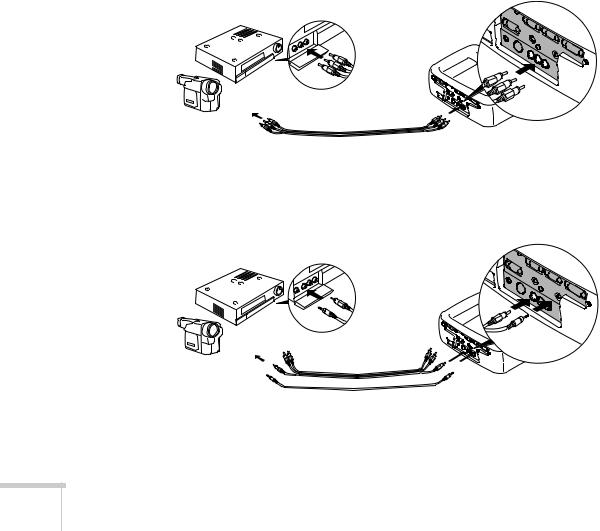
Connecting the RCA A/V Cable
Before starting, make sure the projector and your DVD player or other video source are turned off.
1.Connect the yellow plug on one end of the A/V cable to the projector’s yellow Video jack.
2.Connect the other yellow plug to the video-out jack on your video source.
3.Connect the red and white plugs on the A/V cable to the projector’s Audio L (white) and R (red) jacks.
4.Connect the red and white plugs on the other end of the cable to the corresponding audio output jacks on your video source.
A/V cable
If your video source has a stereo mini-jack instead of RCA jacks, you can use a stereo mini-jack cable (not included). Connect it to the Audio 1 jack on the projector.
A/V cable
stereo mini-jack cable
16 Setting Up the Projector
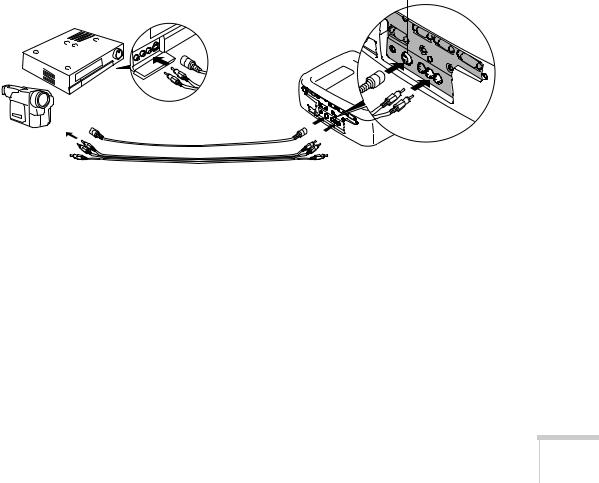
Connecting an S-Video Cable
If your video source has an S-Video jack, you can use it to project a higher quality video image. However, you’ll need an S-Video cable, which may be included with your video source, or can be purchased separately.
Before starting, make sure the projector and your DVD player or other video source are turned off.
1.Insert one end of an S-Video cable into the projector’s S-Video connector.
2.Insert the other end into the S-Video output port of your video source.
3.If your video source has RCA audio, you can use the A/V cable to connect to the projector’s Audio L (white) and R (red) jacks.
S-Video connector
S-Video cable
A/V cable
If your video source has a stereo mini-jack instead of RCA jacks, you can use a stereo mini-jack cable (not included). Connect it to the Audio 1 jack on the projector.
Setting Up the Projector 17

Connecting a Component Video Cable
If your video source has component (blue, green, and red) connectors, you can use them to project a higher quality video image. However, you’ll need a VGA-to-component video cable, which is available from EPSON; see page 7.
Before starting, make sure the projector and your DVD player or other video device are turned off.
1.Connect the VGA end of the cable to the projector’s
Computer 2/Component Video port.
2.Connect the red, green, and blue leads at the opposite end of the cable to the corresponding connectors on your video source.
3.If your video source has RCA audio, you can use the A/V cable to connect to the projector’s Audio L (white) and R (red) jacks.
Computer 2/
Component Video port
VGA-to-component video cable
A/V cable
If your video source has a stereo mini-jack instead of RCA jacks, you can use a stereo mini-jack cable (not included). Connect it to the Audio 1 jack on the projector.
4.If the image doesn’t display properly, you may need to change the Comp2/YCbCr option in the projector’s Setting menu (see
page 56).
18 Setting Up the Projector

2Using the Projector
Once you’ve connected the projector to your computer or other equipment (as described in Chapter 1 or Appendix A), you’re ready to turn on the projector, adjust the image, and give your presentation.
Although you can operate the projector without it, the remote control lets you use additional features. See Chapter 3 for instructions on using the remote. This chapter covers the following:
■Turning on the projector and other equipment
■Adjusting the image
■Controlling the projector
■Shutting down the projector
Using the Projector 19

Turning On Your Equipment
Make sure your projector and other equipment are set up and connected correctly, as described in Chapter 1 or Appendix A. Then turn on your projector, as described below, followed by any equipment you’ve connected to it. You can turn on your computer and video equipment in any order, but if you have more than one computer or video source connected, you may have to switch to the desired source as described on page 29.
Turning On the Projector
Follow these steps to plug in and turn on the projector:
1.If you’re projecting video, first plug in and turn on your VCR, DVD player, or other video source. (If you’re projecting from a computer, go to step 2.)
2.Connect one end of the power cord to the power inlet on the back of the projector.
3.Connect the other end to a grounded electrical outlet. The P power light on top of the projector turns orange, indicating that the projector is receiving power but not yet turned on.
4.Remove the lens cap.
20 Using the Projector

5.Press the red Power button on top of the projector.
The power light flashes green as the projector warms up, and the projection lamp comes on in about 30 seconds. The power light stays green, and you may see a blue screen with the No Signal message displayed. This is normal.
power light
Power button
6.Do one of the following:
■If you’re projecting from a computer, turn on or restart your computer. In a few moments, you should see your computer display projected.
If you see a New Hardware Wizard message saying that it has found a plug-and-play monitor, click Cancel. If you see a New Hardware Wizard message about USB audio, click Next and follow the instructions on the screen. (Windows only).
■If you’re projecting a video, press the Play button on your video source.
If a projected image fails to appear, see the next section for help.
Once you see your image, turn to page 24 for instructions on focusing and making other image adjustments.
When you’re done with your presentation, shut down the projector as described on page 30. Shutting down the projector correctly prevents premature lamp failure and possible damage to the projector from overheating.
warning
Never look into the lens when the lamp is on. This can damage your eyes, and is especially dangerous for children.
Using the Projector 21

No Signal
What To Do If You See a Blank Screen
If you see a blank screen or a blue screen with the No Signal message after turning on your computer or video source, try the following:
■Make sure the cables are connected correctly, as described on page 12 (for laptops) or in Appendix A (for other systems).
■Make sure the power light is green and not flashing and the lens cover is off.
■Try restarting your computer.
■If you’ve connected more than one computer and/or video source, you may need to press the Computer/YCbCr or Video button on the projector’s control panel to select the correct source. (Allow a few seconds for the projector to sync up after pressing the button.)
If you’re using a PC laptop:
■Press the function key that lets you display on an external
monitor. It’s often labelled with an icon such as  but it may also be labelled CRT/LCD. You may have to hold down the Fn key
but it may also be labelled CRT/LCD. You may have to hold down the Fn key
while pressing it. Check your laptop’s manual or online help for details.
On most systems, the  key lets you toggle between the LCD screen and the projector, or display on both at the same time.
key lets you toggle between the LCD screen and the projector, or display on both at the same time.
Allow a few seconds for the projector to sync up after pressing it.
■Depending on your computer’s video card, you might need to use the Display utility in the Control Panel to make sure that both the LCD screen and external monitor port are enabled. See your computer’s documentation or online help for details.
22 Using the Projector
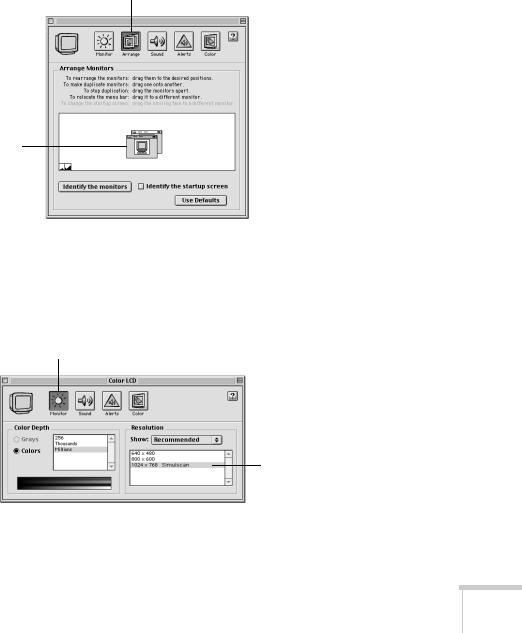
If you’re using a PowerBook or iBook with OS 9.x:
You may need to set up your system to display on the projector screen as well as the LCD screen. Follow these steps:
1.From the Apple menu, select Control Panels, then click
Monitors and Sound.
2.Click the Arrange icon.
click here
drag one monitor icon on top of the other
3. Drag one monitor icon on top of the other.
If the Arrange option isn’t available, you may need to select one of the Simulscan resolution settings:
1. Click the Monitor icon.
click here
select a Simulscan resolution
2.Select a Simulscan resolution as shown. (Allow a few seconds for the projector to sync up after making the selection.)
Using the Projector 23

If you're using Macintosh OS X:
You may need to set up your system to display on the projector screen as well as the LCD screen. Follow these steps:
1.From the Apple menu, select System Preferences, then select
Displays.
2.Make sure the VGA Display dialog box is selected.
3.Click the Arrange tab.
Select the VGA Display dialog box
Make sure Mirror Displays is checked
4. Make sure the Mirror Displays checkbox is selected.
Adjusting the Image
Once you see your image, you’ll need to make certain adjustments:
■To focus or zoom your image, see below.
■If the image is too high or too low, you can reposition it. See page 26.
■If the image isn’t square, see page 27.
■If only part of a computer image is displayed, you may need to press the Resize button. See page 28 for more information.
■If the projected image is flickering or “noisy,” see page 28.
24 Using the Projector
